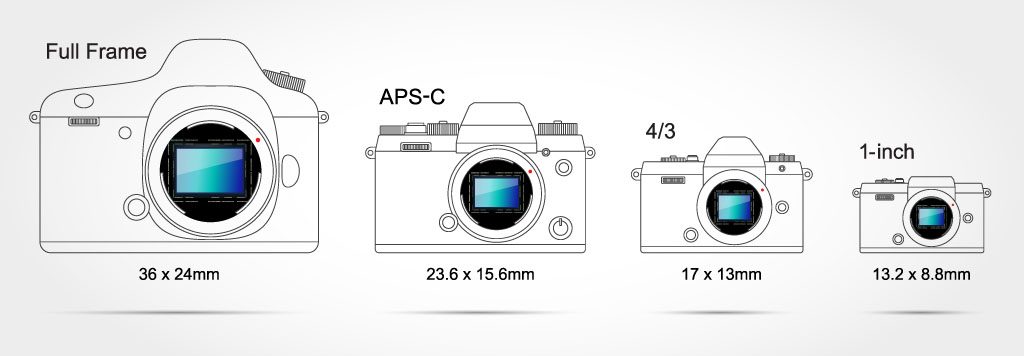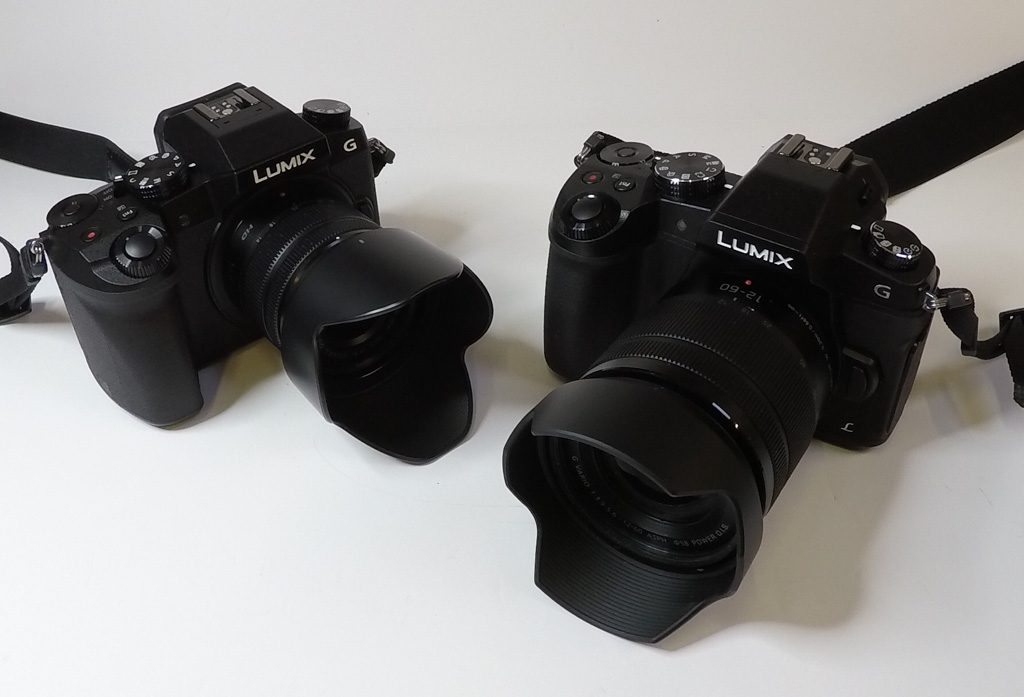
I’ve owned all sorts of digital cameras over the years, my first decent one being the Olympus C2020z back in 1999. I looked through my Lightroom catalogue out of idle curiosity and counted that since then I’ve owned 18 cameras, and that’s not including smartphones or action cameras! What surprised me, was that I’d still taken more photos with digital SLRs than nearly all the other cameras put together, including those off my smartphones. But I ditched my most recent Canon 70D DSLR a couple of years ago because I rarely considered it worthwhile lugging around all that weight.
I went across to a premium compact (with a large 1″ sensor), the Canon G7X, which served me very well. But I required 4K video and a microphone port for some of the videos on this site which led me, based on the price and features I wanted, to the Panasonic’s Lumix G series of mirrorless cameras. These cameras are based on the Micro Four Thirds (MFT) sensor which sits between the larger 1″ sensor size on the premium compacts and the APS-C sensors on most DSLRs, and indeed other mirrorless cameras from Sony.
There are a few advantages to this MFT system:
- Anyone can make bodies and lenses to the MFT standard and they’ll be interchangeable. Although Panasonic and Olympus, who conceived the system, are the driving force;
- The size of the sensor and the fact that the MFT system has been specified for mirrorless cameras means camera bodies can be thinner and lenses smaller and lighter;
- Due to the 2x crop factor, a 300mm lens on a MFT camera has a 35mm equivalent focal length of a whopping 600mm!
There are also disadvantages:
- The smaller sensor is noisier than the larger APS-C and full frame sensors at higher ISOs;
- There is a greater depth of field for a given aperture value due to the 2x crop factor. So to achieve the same background blur with a portrait lens say, at f2.8 on a full frame body, you’d need a f1.4 lens.
The first disadvantage is only an issue if you need to shoot at high ISOs – currently I’d say over ISO 3200 (below that results are pretty close). But all Olympus bodies and many Panasonic bodies feature in-body stabilisation, sometimes combined with lens stabilisation to achieve up to a five stop slower shutter speed. So you can hand hold a 600mm equivalent lens at 1/15s and still get sharp results. Therefore you’d only need to bump up the ISO if you needed to freeze action (with higher shutter speeds) in lower light.
The second disadvantage can be overcome with fast prime lenses. Panasonic do reasonably priced 

But it’s the size and weight of the MFT system and the large choice of lenses that finally drew me in. With a smaller MFT body and one of the many compact, light lenses they are few compromises with a camera that can be close in size to a premium compact, and far more flexible. And far less likely to get left behind than the Canon 70D.
Panasonic’s range of Lumix G cameras

Panasonic have such a confusing range of cameras, but I’ve summarised the current Lumix G range of interchangeable lens models below:
Panasonic's "G Series" range of interchangeable lens cameras
| Model | Name in US / (other regions) | Size | Weight | EVF | Screen | Stabilisation | Mic/Headphone Port | Kit Lens | Weatherproofed | Resolution | Price |
|---|---|---|---|---|---|---|---|---|---|---|---|
| G7* | G7* | 125mm x 86mm x 77mm x | 410g | YES | 3" Articulated | NO | YES/NO | 14-42mm (28-84mm) | NO | 16MP | $499 |
| GX800 | GX850 / GF9 | 106mm x 65mm x 33mm | 269g | NO | 3" Flip up | NO | NO/NO | 12-32mm (24mm-64mm) | NO | 16MP | £499 |
| GX80 | GX85 | 122mm x 71mm x 44mm | 426g | YES | 3" Tiltable | YES 5-Axis Dual I.S. | NO/NO | 12-32mm (24mm-64mm) | NO | 16MP | £550 |
| G80 | G85 / G81 | 128mm x 89mm x 74mm | 505g | YES | 3" Articulated | YES 5-Axis Dual I.S. 2 | YES/NO | 12-60mm (24mm-120mm) Weather Sealed | YES | 16MP | £799 |
| GX8 | GX8 | 133mm x 78mm x 63mm | 487g | YES | 3" Tiltable | YES Dual I.S. | YES/NO | 12-60mm (24mm-120mm) Weather Sealed | YES | 20MP | £879 |
| GH5 | GH5 | 138mm x 98mm x 87mm | 725g | YES | 3" Articulated | YES 5-Axis Dual I.S. 2 | YES/YES | 12-60mm (24mm-120mm) Weather Sealed* | YES | 20MP | £1,899 |
**£2199 for model with Leica 12-60mm f2.8-4.0
I started with the G7 but just recently upgraded to the new G80, partly for the kit lens but I also really like the in-body stabilisation that can be used with any lens, and the weather sealing. I’ve highlighted the differences between the G7 and the new G80 (G81/G85 in other regions) below which might be helpful if you are choosing one of these models or looking to upgrade.
Differences between the Panasonic G7 and the new G80 (G85/G81 in other regions)
| Panasonic G7 | Panasonic G80 (G85/G81 other regions) | |
|---|---|---|
| Body stablisation | None, relies on IS in lens | Yes: YES 5-Axis Dual I.S. 2 which is the latest version offering up to 5 stops of stablisation |
| Kits Lens | 14-42mm, although can be bought 12-60mm | 12-60mm weather sealed lens compatible with latest Dual I.S. 2 |
| Weather Sealing | None | Yes, both body and included 12-60mm lens. Although no IPX rating given |
| SD Card Position | Bottom of camera with battery | Side of camera. Much easier to access, especially when on tripod |
| 25/50fps and 30/60 fps | No 30/60fps option for cameras in PAL regions | All frame rates now offered - very nice to have this flexibility |
| SD Card File Size Support | Files broken into 4GB chunks | With latest SDXC cards, can support files sizes larger than 4GB - video files not fragmented |
| Video Length Limit | 30 minutes maximum | Same maximum on G80/G81. But limited has been lifted on G85 |
| Focus Stacking | Not supported | Supported |
| Mechanical Shutter | Some reports caused vibrations at some shutter speeds | Much quieter mechanical shutter, with reduced vibration. Also new Electronic Front Curtain (EFC) shutter |
| AF Sensitivity | No control over AF sensitivity | Speed of Continuous AF for video can now be adjusted |
| Bracket Drive Mode | Option on drive dial for bracketing | This option has now been changed to Post Focus |
| Panorama Mode | Can select from mode dial | No longer possible to select from mode dial but still available |
| Buffer Size | 100 JPEGS, or 13 RAW | Significant upgrade to 300 JPEGS or 45 RAW. Also shows a live countdown of space left in buffer bottom right of LCD (r39, r38 etc) |
| HDMI Output | No display while recording video | Will display live view while recording, including peaking |
| Custom Modes | One C dial position that can hold 3 sets of camera settings | Two custom modes dial positions C1 & C2. C2 can hold 3 sets of camera settings |
| Mic Socket | Near hot shoe, doesn't interfere when moving articulated screen | Moved down to side of camera. Can interfere with LCD screen |
| 4K Live Cropping | Not supported | Supports this feature to setup a pan and zoom at 1080p (using the 4K video resolution) |
| Burst Speed | 8fps in AFS focus mode | 9fps in AFS focus mode |
| Other Changes | -Wider strap -Flash design changed. Output very slightly less -Deals feel stiffer dues to weather sealing -Light composition feature -Bulk save 4K feature added -EVF power save mode added -Focus and aperture bracketing |
My experiences going mirrorless and specifically Micro Four Thirds
Even upgrading to the G80 (from the G7) with its slightly heavier (more robust) body and larger kit lens, I am still enjoying the size and weight benefits of the MFT system. I would still like to own the Canon G7X for the times when I don’t want to carry even this, but I couldn’t afford to keep both!
The G80 has the best controls and features of any camera I’ve owned. It can be a little overwhelming with the amount of features this camera has – the manual is 340 pages long! But once you understand all these features and configure the camera in a way that suits you, it’s so enjoyable to use.
The image quality is excellent and I haven’t noticed any real disadvantages compared to the Canon 70D I owned previously. I’ve now sold my Canon lenses and accessories and am slowly building up my MFT collection. Expect more posts :).
If you have found this article useful please consider clicking on the link(s) below. You pay the exact same price and it’ll enable me to keep these articles coming!
Any questions, please ask away in the comments section below.
Which manual is 340 pages, exactly? I haven’t been able to find this.
The G80/G81 advanced manual available for download: https://tinyurl.com/n7s8u3s or here for the US G85: ftp://ftp.panasonic.com/camera/om/dmc-g85_en_adv_om.pdf
Skype has established its internet-dependent consumer beta for the entire world,
following establishing it extensively in the U.S. and You.K.
earlier this 30 days. Skype for Website also now supports Chromebook and Linux for instant
text messaging connection (no voice and video however, those call for a connect-in set up).
The increase of your beta brings assist for an extended listing of different languages to assist reinforce
that overseas usability